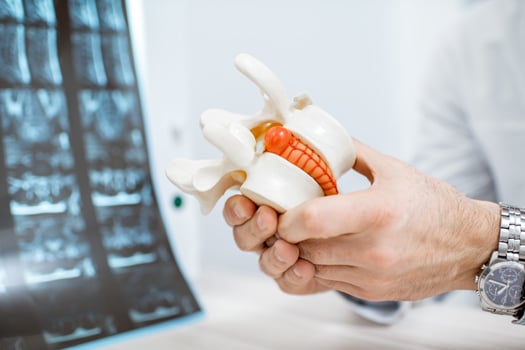
If you have undergone surgery to treat a herniated disc, you may be wondering about the likelihood of the disc reherniating. It is a valid concern, as the risk of reherniation can affect your recovery and long-term prognosis. This article will explore the likelihood of disc reherniation, factors that can increase the risk, and how you can reduce your chances of experiencing this complication.
What Is Disc Reherniation?
Disc reherniation is a complication that can occur after a discectomy or less invasive microdiscectomy to treat a herniated disc. A herniated disc occurs when the soft, jelly-like substance inside the disc bulges or ruptures through the tough outer layer, putting pressure on nearby nerves and causing pain and other symptoms. Surgical treatment for a herniated disc typically involves removing the damaged portion of the disc and possibly fusing the vertebrae together through spinal fusion surgery.
Disc reherniation occurs when part of the disc bulges or ruptures again after surgery. This can happen if the disc was not completely removed during the initial surgery, if the remaining disc material degenerates and bulges out, or if new disc material herniates at a different location. The risk of reherniation can depend on a variety of factors, including the patient's age, the severity of the initial herniation, and the type of surgery performed.
What Factors Can Increase the Risk of Disc Reherniation?
Several factors can increase the risk of disc reherniation after surgery. These include:
- Age – Older patients may be more prone to disc reherniation due to age-related degeneration of the spine and decreased healing capacity
- Severity of initial herniation – The more severe the initial herniation, the greater the risk of reherniation after surgery
- Smoking – Smoking can impair the body's ability to heal and increase the risk of complications, including disc reherniation
- Heavy lifting – Lifting heavy objects or engaging in strenuous activity too soon after surgery can increase the risk of disc reherniation
- Inadequate healing time – Rushing back to normal activities too soon after surgery can increase the risk of complications, including reherniation
- Poor spinal alignment – If the spinal alignment is not properly restored during surgery, it can increase the risk of disc reherniation
What Is the Likelihood of Disc Reherniation?
The likelihood of disc reherniation can vary depending on the specific case and the surgical approach used. Generally speaking, the risk of reherniation is low, with some studies suggesting a reherniation rate of around 5 to 15 percent. However, other factors, such as smoking, can increase the risk of reherniation and lead to another discectomy or even spinal fusion surgery.
How Can You Reduce Your Risk of Disc Reherniation?
While the risk of disc reherniation cannot be eliminated entirely, there are steps you can take to reduce your chances of experiencing this complication. These include:
- Following post-surgery instructions – It is important to follow your doctor's instructions regarding activity level, lifting restrictions, and medication use after surgery
- Gradually returning to activity – You should gradually increase activity levels over time rather than returning to normal activities too soon
- Quitting smoking – If you smoke, quitting can reduce the risk of complications and promote healing after surgery
- Maintaining a healthy weight – Being overweight can put additional stress on the spine, increasing the likelihood of reherniation
Even though discectomy surgery is a common and generally quite successful procedure, a hole is frequently left in the outer wall of the disc. In fact, patients with these large holes in their discs are more than twice as likely to reherniate. Reherniations often require additional surgery or even fusions. Fortunately, there is a new treatment specifically designed to close the large holes that are often left in spinal discs after discectomy surgery. Barricaid is a bone-anchored device proven to reduce reherniations, and 95 percent of Barricaid patients did not undergo a reoperation due to reherniation in a 2-year study timeframe. This treatment is done immediately following the discectomy—during the same operation—and does not require any additional incisions or time in the hospital.
If you have any questions about the Barricaid treatment or how to get access to Barricaid, ask your doctor or contact us at 844-288-7474.
For full benefit/risk information, please visit: https://www.barricaid.com/instructions.


Comments